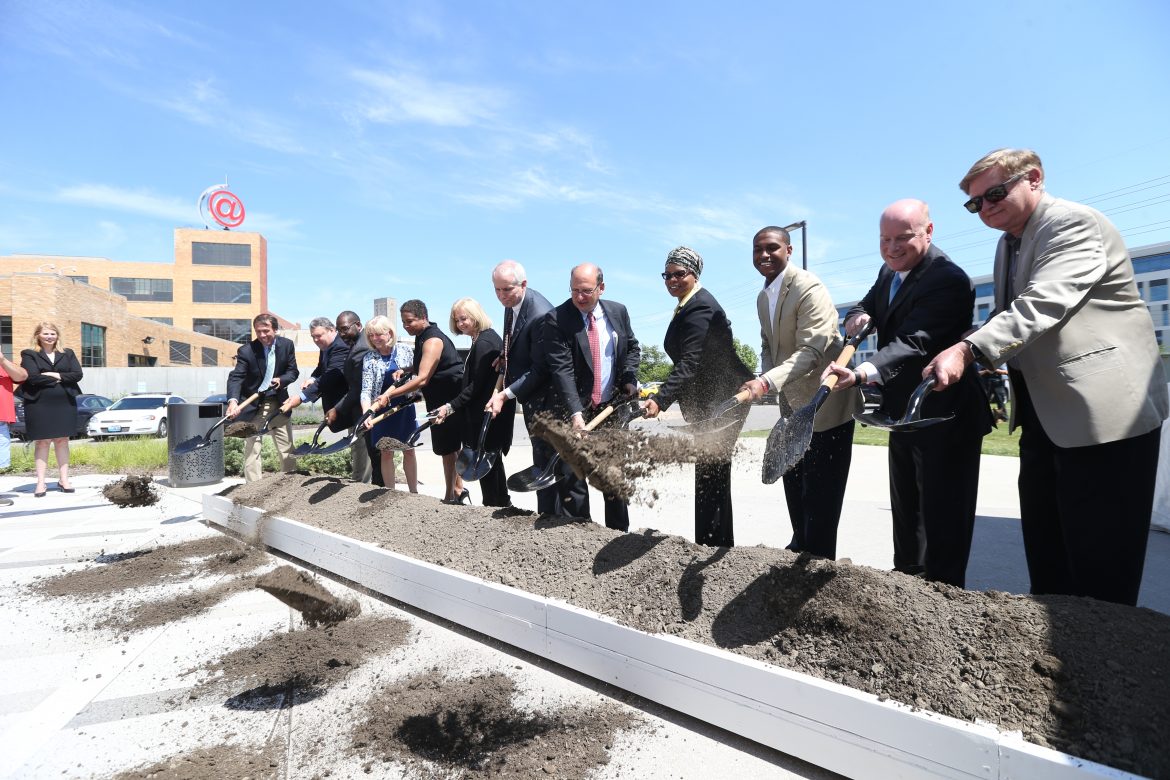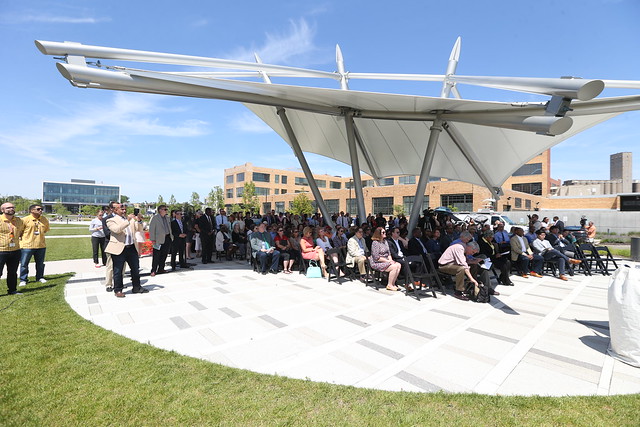
Construction on the first new MetroLink station to be built in the St. Louis region in more than a decade will begin this summer in the Cortex Innovation Community, which is in the central corridor of the City of St. Louis, Missouri. Regional leaders joined project partners and the public on June 8 for the ceremonial groundbreaking for the new Cortex MetroLink Station and Chouteau Greenway, a paved path where people can walk, run or ride a bike. The new station will provide another transportation option for those who will fill an estimated 13,000 permanent jobs expected to be created in the Cortex Innovation Community and throughout the central corridor. This is the first Metro station to be built from public and private funds.
Representatives from the funding partners — Cortex Innovation Community, Great Rivers Greenway, Washington University, BJC HealthCare and the City of St. Louis — joined Metro and Bi-State Development to kick off the project. The new MetroLink station will become the 38th station to be constructed on the current light rail system, and will be located between the Grand Station and Central West End Station, between Boyle Avenue and Sarah Street. The project also calls for the extension of the platform at the Central West End MetroLink Station, which has the highest ridership on the entire alignment.
“This public-private partnership is an outstanding model for how the region, and the nation, can approach infrastructure needs in the future,” said John Nations, President and Chief Executive Officer of Bi-State Development, whose Metro enterprise operates the MetroLink light rail system for the region. “Projects like this are more important than just helping people get from point A to point B. It is about making an investment in our community; an investment that will help attract workers and create new jobs; an investment that will serve as a catalyst for new business and economic development; an investment that will position the City of St. Louis and the entire bi-state region for even more prosperity and success in the years to come.”
St. Louis Mayor Lyda Krewson spoke about the importance of the project. “Young people want to live and work in safe, fun, walkable communities; and employers want the same,” said Krewson. “This new MetroLink station is part of that equation. Anytime we can make it easier to get to work, school or other destinations, we’re doing our part to make the city grow.”
Also speaking at the event to provide more details about the greenway element of the project was Susan Trautman, Chief Executive Officer at Great Rivers Greenway. This project includes the first quarter-mile section of the Chouteau Greenway that will be built between Boyle and Sarah Avenues. When the entire five-mile greenway is complete, people will be able to walk or ride a bike all the way from the Gateway Arch to Forest Park—on a paved, accessible greenway that is separate from the street.
“We are at the beginning of the vision for the Chouteau Greenway, which eventually will connect Forest Park, Washington University Medical Center, Barnes-Jewish Hospital, Cortex Innovation Community, St. Louis University, Harris Stowe, the downtown business district and neighborhoods north and south,” Trautman said. “This marks the first step in the project, and with our many partners, we will develop this greenway as a common ground to enrich lives, strengthen relationships, bridge communities and create places that attract and retain talent and improve quality of life.”
Joseph Roddy, St. Louis Alderman for the 17th Ward, said the project is already having a positive impact. “The anticipation of this station has already led to development rippling in every direction from here,” Roddy said. “What you’re doing here by making this investment, letting the train stop here, is really transformative. It will change the lives of hundreds, if not thousands of people.”
Hank Webber, chairman of Cortex, talked about the 4,000 people already employed by companies in the Cortex Innovation Community and what the project means to them and the others who will join them as they continue on their path to creating 13,000 jobs within the next 10 years.
“They want to live in a region that has a vibrant public transit system,” said Webber. “This is about connections between large institutions and small firms, and how a region goes from pockets of great strength to a great whole.”
One of those large institutions, BJC HealthCare, has more than 1,000 employees in the corridor to be served by the new station and whose main campus surrounds the busy nearby Central West End MetroLink Station.
“At BJC, we focus on our vision of making medicine better, but we also focus on making the St. Louis region better,” said June McAllister Fowler, Senior Vice President, Communications, Marketing and Public Affairs. “Public transit plays a critical role in achieving this goal.”
That sentiment was shared by Washington University’s Vice Chancellor for Operations and Technology Transfer Dedric Carter. Washington University is Metro’s largest university pass customer.
“Washington University has been a historic and strong supporter of public transit as part of a robust transportation strategy for the University. We believe this project will be catalytic for our community,” said Carter. Using a quilting analogy, he went on to state “The station is an important stitch in the fabric of St. Louis.”
Primary funding for the project is provided from a $10.3 million Transportation Investment Generating Economic Recovery (TIGER) grant from the U.S. Department of Transportation. The remaining funds for the estimated $15 million project will come from Cortex Innovation Community, Great Rivers Greenway, Washington University, BJC HealthCare and the City of St. Louis/St. Louis Development Corporation. Bi-State Development was one of nearly 800 applicants from around the country for a TIGER grant, and this project as one of just 72 that were actually awarded grant money, representing quite an achievement.
“This great public-private partnership will improve the MetroLink infrastructure for the benefit of the transit riding public, and that, in turn, will enhance the entire community,” said Ray Friem. Friem, the Executive Director of Metro Transit, is leading the project with the assistance of the Metro team. “This partnership can serve as a model for future transit infrastructure projects.”
Additional partners whose support and advocacy helped make this project possible include Citizens for Modern Transit, which led the effort to develop the draft feasibility study for the new station in 2014; East-West Gateway Council of Governments; Missouri Department of Transportation; IKEA; Wexford Science and Technology, and several federal and local officials, including U.S. Senator Claire McCaskill and former St. Louis Mayor Francis Slay.
“This station, this project, this partnership is about so much more than its individual elements,” said Nations. “It’s about getting the best of St. Louis to do the best for St. Louis.”
The project is expected to support approximately 170 construction jobs and is slated for completion in 2018. HNTB Corp. led the project design team, which included KAI, Access Engineering, Glasper Professional Services, TSi Geotechnical and Kivindyo Engineering Services, all of St. Louis.
About BJC
BJC HealthCare is one of the largest nonprofit health care organizations in the United States, delivering services to residents primarily in the greater St. Louis, southern Illinois and mid-Missouri regions. Serving the health care needs of urban, suburban and rural communities, BJC includes 15 hospitals and multiple health service organizations. Services include inpatient and outpatient care, primary care, community health and wellness, workplace health, home health, community mental health, rehabilitation, long-term care and hospice. BJC’s nationally recognized academic hospitals, Barnes-Jewish and St. Louis Children’s hospitals, are affiliated with Washington University School of Medicine
About Bi-State Development
Bi-State Development (BSD) owns and operates St. Louis Downtown Airport and the Gateway Arch Riverboats, as well as operates the Gateway Arch Revenue Collections Center and Gateway Arch trams. BSD is the operator of the Metro public transportation system for the St. Louis region, which includes the 87 vehicle, 46-mile MetroLink light rail system; a MetroBus vehicle fleet of approximately 400 vehicles operating on 79 MetroBus routes; and Metro Call-A-Ride, a paratransit fleet of 120 vans. BSD also operates the Bi-State Development Research Institute and the St. Louis Regional Freightway, the region’s freight district.
About CORTEX
Founded in 2002 through a collaboration between Washington University in St. Louis, BJC Healthcare, the University of Missouri-St. Louis, Saint Louis University, and the Missouri Botanical Garden, the Cortex Innovation Community (CortexSTL.com) is the Midwest’s leading hub of innovation and technology commercialization, serving as the anchor of St. Louis’ growing ecosystem for innovative startup programs and established companies. Cited by the Brookings Institution as a model of an urban innovation district, Cortex is home to more than 250 technology-related firms, providing a deep pool of entrepreneurial programs that support emerging technology companies and attracts established technology firms to St. Louis.
About Great Rivers Greenway
Great Rivers Greenway (GRG) is a regional public agency created in 2000 by a vote of the people. The mission of GRG is connecting the St. Louis region with greenways so people can explore their rivers, parks and communities, making it a vibrant place to live, work, and play. The agency strengthens the region’s vibrancy through collaboration that brings people together, from citizens to government agencies and nonprofits to private companies and everyone in between. Greenways are planned, brought to life and cared for in partnership with the 100+ municipalities and institutions they connect.
About Metro
Metro is the operator of the St. Louis region’s public transportation system, which includes the 87 vehicle, 46-mile MetroLink light rail system; approximately 400 vehicle MetroBus fleet that operates on 80 MetroBus routes in Missouri and Illinois; and Metro Call-A-Ride, a paratransit fleet of 122 vans. Metro is an enterprise of Bi-State Development (BSD), which also owns and operates St. Louis Downtown Airport, the Bi-State Development Research Institute, the Gateway Arch Riverboats, and operates the Gateway Arch Trams and Revenue Collections Center. BSD also operates the St. Louis Regional Freightway.
About Washington University
Washington University in St. Louis is counted among the world’s leaders in teaching, research, patient care and service to society. The university draws students to St. Louis from more than 80 countries and all 50 states, the District of Columbia, Guam, Puerto Rico and the Virgin Islands. The total student body is more than 14,000 undergraduate, graduate and professional students. The approximately 3,600 faculty teach in seven schools: Arts & Sciences, Brown School, Olin Business School, Sam Fox School of Design & Visual Arts, School of Engineering & Applied Science, School of Law and School of Medicine. The university has been affiliated with 24 Nobel laureates, many of whom did a significant portion of their award-winning work at the university. The university offers more than 90 programs and almost 1,500 courses leading to bachelor’s, master’s and doctoral degrees in a broad spectrum of traditional and interdisciplinary fields, with additional opportunities for minor concentrations and individualized programs.

